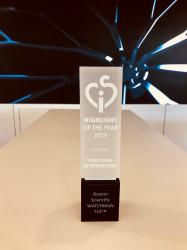WATCHMAN™ FLX LAAC System Receives CSI Highlight of the Year Award in Structural Category

The next-generation WATCHMAN™ FLX Left Atrial Appendage Closure (LAAC) System has received the CSI Highlight of the Year Award in the Structural category. Voted on by physician attendees at the CSI Frankfurt 2019 congress, the award recognizes congenital, structural and valvular heart disease intervention technologies that will have the biggest impact in the field, on daily practice or on patients’ health and outlook. CSI is an international organization dedicated to promoting developments in the area of heart disease technology, innovation and medical device development.
Physicians presented during the meeting about their early experiences with the WATCHMAN FLX device during its limited market release in Europe this year, and highlighted the benefits of this new technology, especially in challenging anatomies.
Patients with atrial fibrillation (AF) are five times more likely to suffer a stroke than patients with a normal heart rhythm.1 In people with non-valvular AF, data suggests that more than 90% of stroke-causing blood clots that come from the heart are formed in the left atrial appendage.2 The WATCHMAN LAAC devices are intended to reduce the risk of stroke in people with this condition. Delivered via a one-time, minimally invasive procedure, the next-generation WATCHMAN FLX technology was designed for simplified implantation to fit a wider range of patients. It allows physicians flexibility to customize placement, and the ability to fully recapture and reposition the device during the procedure.
“This award reflects our global team’s dedication to providing physicians and their patients with the most advanced therapeutic alternative to a lifetime on blood thinning medications,” said Nicholas Spadea-Anello, global vice president and general manager, WATCHMAN Franchise, Boston Scientific. “The WATCHMAN FLX device, which has now been implanted in more than 250 patients in Europe, was built upon the proven WATCHMAN technology that has already served more than 90,000 patients worldwide.”
In the U.S., the device is investigational and not available for sale.
1 "Atrial Fibrillation Fact Sheet." Centers for Disease Control and Prevention. http://www.cdc.gov/dhdsp/data_statistics/fact_sheets/fs_atrial_fibrillation.htm.
2 Blackshear JL, Odell JA. Appendage obliteration to reduce stroke in cardiac surgical patients with atrial fibrillation. Ann Thorac Surg. 1996;61:755-759.